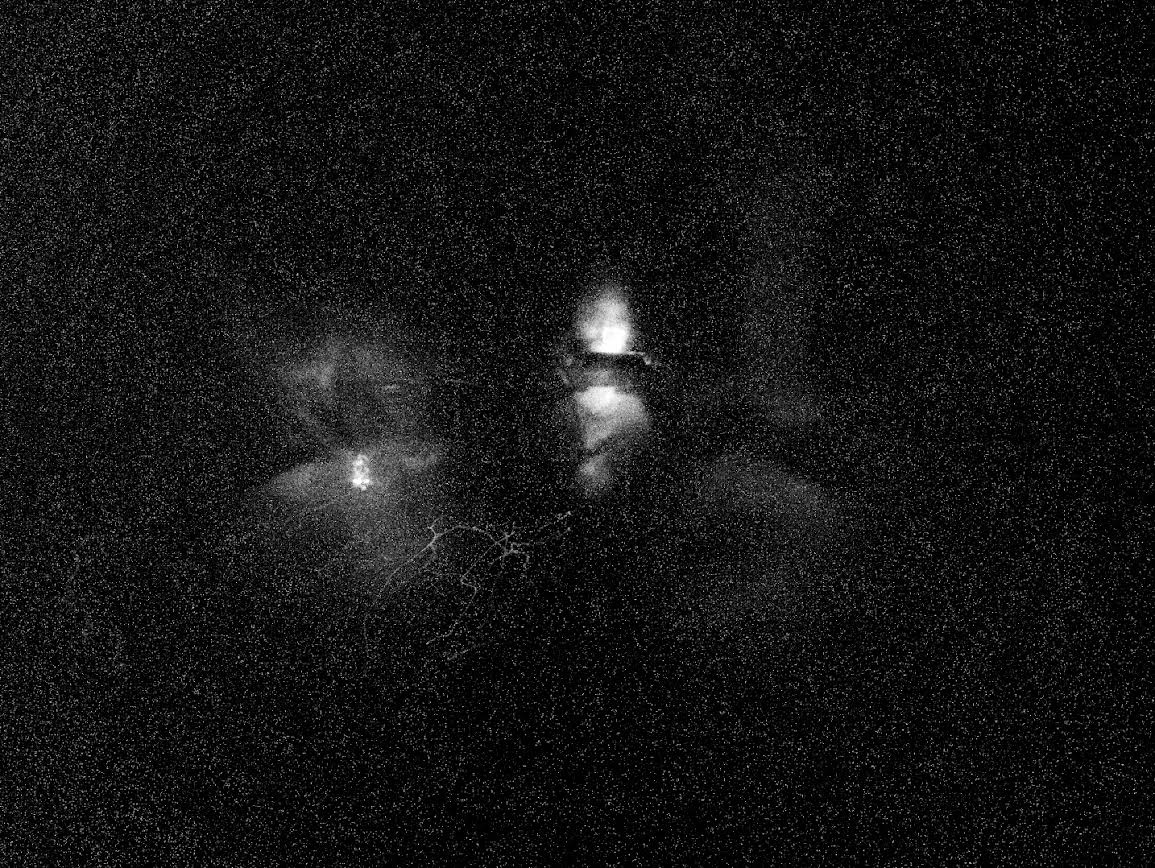ABOUT THE WRITERS
Alden Nagel is the founder and editor of Nut Hole Publishing. He has an upcoming novella entitled Salination Mountains.
Rushnan Jaleel is a filmmaker and artist based in Mumbai, India. He graduated from Emerson College and Paris College of Art in 2022, having earned a Bachelor of Fine Arts Degree in Film Art (Global BFA).
His work explores being, absence, light, and the abstraction of the visible through a variety of digital techniques such as the use of low-end cameras, layering and re-photography.
Alden Nagel: What was your formative film experience as a child?
Rushnan Jaleel: There are several. However, rather than pointing to a specific film I would like to mention a small fragment of a recollection from an early visit to the theater. I no longer remember the film in question, but I do remember when, as a child, I unwittingly turned away from the screen and saw the light radiating from the projector for the first time in my life – the coruscating dust held aloft in the beam. I remember falling asleep with the memory of that light gently impressing itself on my eyes. It felt as though everything within me had suddenly been emptied and attached itself to the walls of the cinema hall. The experience did more to affect my perception of cinema than any film or artist in particular.
Alden Nagel: What were your very first efforts with filmmaking like?
Rushnan Jaleel: I had a strong inclination towards working alone from the first moment I held a camera. As a child, I was very drawn towards stop-motion animation and I would create these little videos with my action figures. Later on, when I started to seriously consider pursuing filmmaking, I adopted a more traditional approach and worked with a small group of friends and family for a number of projects. I would come to resent this way of working, however. Spurred on by my discovery of experimental filmmakers – chief among them the likes of Phil Solomon, Stan Brakhage, Jean-Claude Rousseau, Scott Barley, Andrew Noren, Robert Beavers, Maya Deren, Michael Snow, Nathaniel Dorsky, Baker Ahmed, and Jordan Belson – I felt empowered to work on my own, to become self-sufficient. I see my recent work as a return to that childish and intuitive mode of working at the same time as I see it in kinship with the work of the artists I’ve mentioned.
Alden Nagel: How does darkness resonate with you in how you craft your films?
Rushnan Jaleel: The experience of darkness informs every aspect of my making and thinking about cinema. My films are created in near-complete darkness, whether that means filming predominantly at night or editing in a darkened room.
Alden Nagel: What you do feel is the ultimate form of darkness that can be expressed in cinema, and how?
Rushnan Jaleel: An interesting question because darkness is, as I understand it, the ultimate form of cinema available to us. Those who are conditioned – or perhaps condemned – to spend most of their waking hours in darkness are acutely aware of this. The essence of darkness is not in absence, but in the pareidolia that arises from the ravages of our maladaptive eyesight. In the dark, images come unstuck like larvae hatching from putrescent eggs.
In my ongoing work, I find myself increasingly disinterested in representing degrees of luminosity or exposure in relation to our traditional associations of light and dark. I’m more taken with vision itself – the sheer voluminosity and violence with which ‘shut-eye patterns’ (to borrow a phrase from Brakhage) burn themselves on the screens of our eyelids, helicoidal tendrils unburying images faster than we can hope to assimilate them. A dream that leaves aftershocks on the retina can sting for hours upon waking in a lightless room. Darkness allows us to give rein to the demons holding fort. If a film can do such violence to a viewer’s psyche as to excoriate the flesh around their eyes, to send ghosts careening through the room, we can say that it has expressed something about the dark.
Alden Nagel: What about the invisible world fascinates you in your work, as a dualism with the visible world?
Rushnan Jaleel: The visible is always a comment on the invisible. Cinema allows for a disembodied experience of the world that I find endlessly alluring – both film and viewer are bound by a relational absence and an absence of relations at the same time. To encase an object in the borders of a frame is to erase it. I see my work as an attempt to invisibilize the world or to make absence itself visible, to disappear things by filming them.
Ultimately, it’s me who is invisible in my images. Being in front of the camera is a form of self-effacement as well, of course, but in my case – I am not only absent in the image, I am also absent behind the camera. I work to erase any interlocutors between the viewer and the work. Of course, all of these stages involve my being, my body and my spirit – but this contradiction doesn’t negate the impulse to dissolve myself in my work, but rather, fuels it. I see my work as an attempt to dialogue with whatever it is that lies outside the periphery of my own understanding – with the outside itself.
Alden Nagel: How did you create the images utilized in your film The Angel of Forms, prior to the post-production stage?
Rushnan Jaleel: I create images entirely out of a sense of intuition – never intention. Each image in the film has a history behind it. Most were created through extensive editing of spontaneously-filmed smartphone footage. The penultimate sequence in the film features a blue, anthropocentric form that arises from a black backdrop. The basis of this image was a discarded piece of footage from a much more traditional, narrative-based work which I finished – and subsequently abandoned – as far back as 2016.
There’s also a sequence towards the end that features a series of (macro and micro) cosmic phenomena, fractals and whorls of starlight – these images come from an ashtray through which light was projected.
Alden Nagel: How has literature become elemental with your work as a director?
Rushnan Jaleel: Language as a whole is elemental with my work in film, and elsewhere. We know that language creates absence, that it tears holes within itself. I think I try to do this with my visual work as well, where the images themselves dissolve the instant they are apprehended.
I still consider myself a neophyte when it comes to literature, but I am naturally drawn towards writers who aim to obfuscate rather than communicate.
Beckett’s influence on my work is perhaps more vast than any other artist. I first read his ‘trilogy’ of novels – Molloy, Malone Dies & The Unnamable – in college. I remember how slowly I trawled through the last of those novels, re-reading every page at least twice to absorb the extraordinarily intricate involutions of prose – as if every sentence were a fractal of the entire novel. I read slowly as if to prolong the devastation I experienced. A novel wrestling with itself, erasing itself even as it comes into being. It was unlike anything I’ve encountered before or since – abyssal in its endlessness. Perhaps the only other work of fiction that has affected me this violently would be Blanchot’s Thomas the Obscure.
Lately, I also find myself deeply in love with the poetry of Alejandra Pizarnik. Her poems are at once devastatingly simple and eviscerating in their fragility – they bring you into an intimacy with the writer that is perhaps deeper than any other I have encountered. I often think of Pizarnik as the writer who can reduce me to nothing with the fewest words.
Alden Nagel: How did you first become fascinated with the concept of undinal beings?
Rushnan Jaleel: I first came across the word ‘undinal’ through the poetry of Hart Crane, and specifically this extraordinary verse from Voyages II –
—And yet this great wink of eternity,
Of rimless floods, unfettered leewardings,
Samite sheeted and processioned where
Her undinal vast belly moonward bends,
Laughing the wrapt inflections of our love;
When I first read these words, the images I had been working on for years suddenly fell into place. Beside this, I have a lifelong fascination with water and with the ocean. Many of my childhood memories involve my experience of the water. The weightless liquidity of water, the sensation of slipping into something so full, of disappearing into it is something I think about very often. I see as if through misted eyes, as though a film of water were always veiling my sight. Water holds in it the entire story of being.
Alden Nagel: How do you view the importance of total silence within cinema, in relation with the traditional understanding of its necessity—often thought of as transcending or being more important as an experiential totality to the visual image?
Rushnan Jaleel: If the images of a film exist at all, they do so in order to disappear. The same principle applies to sound – it is predicated on its disappearance into silence. The measure of an experience that is cinematic has to do with the finitude of that experience. Cinema is what you can’t hold with your hands, yet it reaches you. It is the most incorporeal medium. We have a conception of sound being more powerful than or overriding the visual image and there is a strong foundation for this, empirically. As Bresson suggested, ‘The ear goes more toward the within, the eye toward the outer.’ However, an image can force the eye to wander within if it coalesces with silence as well, if it touches the real through the inner fulgurations of montage or through the sense of becoming that comes from duration. What I have observed is that sound is often used to conceal something the image lacks. And while that can lead to powerful results, I am slowly moving towards stripping away the comfort it provides. The presence of sound is reassuring – a cloak of invisibility that allows viewers to dissolve in communion. Silence requires some risk. Shared silence, whether in the aftermath of sound or in its absence altogether, can either render an image null or inspire paroxysmal awe. Finally, there is a sound in every image – especially a silent image. The sound is there in the colour, it is there in the texture, it is there in the rhythm. The silence is the sound of the image itself. It is the image. The images make music together, and that music is different for every viewer.






